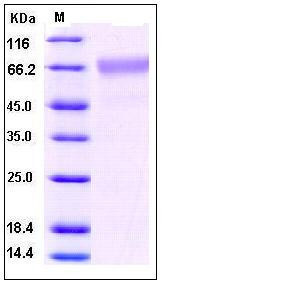Human BACE1 / ASP2 Protein
ASP2,BACE,HSPC104
- 100ug (NPP3593) Please inquiry
| Catalog Number | P10064-HCCH |
|---|---|
| Organism Species | Human |
| Host | Human Cells |
| Synonyms | ASP2,BACE,HSPC104 |
| Molecular Weight | The recombinant human BACE1 consists of 442 amino acids and has a calculated molecular mass of 49 kDa. As a result of glycosylation, the rhBACE1 migrates as an approximately 65 kDa protein in SDS-PAGE under reducing conditions. |
| predicted N | Thr 22 |
| SDS-PAGE |  |
| Purity | > 95 % as determined by SDS-PAGE |
| Protein Construction | The mature form of human BACE1 (NP_036236.1) extracellular domain (Met1-Thr 457) with a quinary-aa peptide (DDDDK) at the C-terminus was expressed and purified. |
| Bio-activity | Measured by its ability to cleave a fluorescent peptide substrate Mca-Ser-Glu-Val-Asn-Leu-Asp-Ala-Glu-Phe-Arg-Lys(Dpn)-Arg-Arg-NH2 (Catalog# ES004, R&D Systems). Cleavage of ES004 can be measured using excitation and emission wavelength of 320 and 405 nm, respectively. The specific activity is >0.5 pmoles/min/μg . |
| Research Area | |
| Formulation | Lyophilized from sterile 50mM Tris, 100mM NaCl, pH 8.0 1. Normally 5 % - 8 % trehalose and mannitol are added as protectants before lyophilization. Specific concentrations are included in the hardcopy of COA. |
| Background | Beta-site APP-cleaving enzyme 1 (BACE1) is an aspartic-acid protease important in the formation of myelin sheaths in peripheral nerve cells. In the brain, This protein is expressed highly in the substantia nigra, locus coruleus and medulla oblongata. Strong BACE1 expression has also been described in pancreatic tissue. BACE1 has a pivotal role in the pathogenesis of Alzheimer's disease. In Alzheimer's disease patients, BACE1 levels were elevated although mRNA levels were not changed. It has been found that BACE1 gene expression is controlled by a TATA-less promoter. The translational repression as a new mechanism controlling its expression. And the low concentrations of Ca(2+) (microM range) significantly increased the proteolytic activity of BACE1. Furthermore, BACE1 protein is ubiquitinated, and the degradation of BACE1 proteins and amyloid precursor protein processing are regulated by the ubiquitin-proteasome pathway. It has also been identified as the rate limiting enzyme for amyloid-beta-peptide (Abeta) production. |
| Reference |
